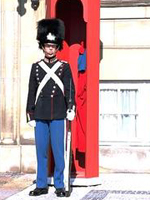
Standing guard at the Amalienborg Palace
© AA Photo Library
If you drive or cycle through Denmark, ask the tourist office for details about the “Marguerite Route,” which is a series of linked routes (2,100 miles long) along quieter roads through the most scenic parts of the country. Signs display a daisy (marguerite) motif on a brown background. A map, free from the Danish Tourist Board, indicates the route.
Danes celebrate Midsummer Eve (Sankt Hans) on June 23. Bonfires are lit throughout the country on the longest day of the year.
In Denmark morgenmad is the word for breakfast, while frokost is lunch. Smørrebrød, the tasty Scandinavian open-faced sandwich, remains a lunchtime favorite; but try frikadeller, delicious fried meat or fish patties with salad and potatoes; or dip into the heftier koldt bord, a buffet-style selection. For main meals, enjoy kogt torsk, poached cod in mustard sauce, or old-fashioned Skipper labskovs, Danish stew.
Delicious Danish pastries are called wienerbrød and come in a variety of shapes and tasty flavors. In every town and large village you will find a bakery selling pastries.
Amber is a Danish specialty, the “Danish gold.” The Amber Specialist (28 Frederiksberggade, Copenhagen, Phone: 33 11 88 03) is the place to look in Copenhagen, but you will find distinctive amber jewelry in stores throughout the country. If you're shopping for a colorful Scandinavian sweater go to Sweater Market (15 Frederiksberggade, Copenhagen, Phone: 33 15 27 73), Europe's largest sweater store.
Denmark, like Sweden, is noted for its distinctive furnishing designs. The style known as “Danish Modern” is a classic merging of the functional with the aesthetic. Visit Illums Bolighus (Amagertorv, Copenhagen, Phone: 33 14 19 41) for some of the finest examples.
Unlike the northern Scandinavian countries, Denmark has a far more relaxed approach to the sale of liquor. You can buy wines, spirits and beers in grocery stores, and you may find that prices are lower than in Norway, Sweden or Finland.
Traditionally formal, Danes have become more relaxed about what to wear when eating out. Smart, casual clothes, especially during the warm summer months, are acceptable for dining at most Danish restaurants.
| COUNTRY |
| Introduction |
| Things To Know |
| Survival Guide |
| TimeLine |
| Essential Info |
| REGION |
| CITIES |
| Copenhagen |
| Odense |
| MAPS |
| World |
| Europe |
| TRAVEL BOOK |
 |